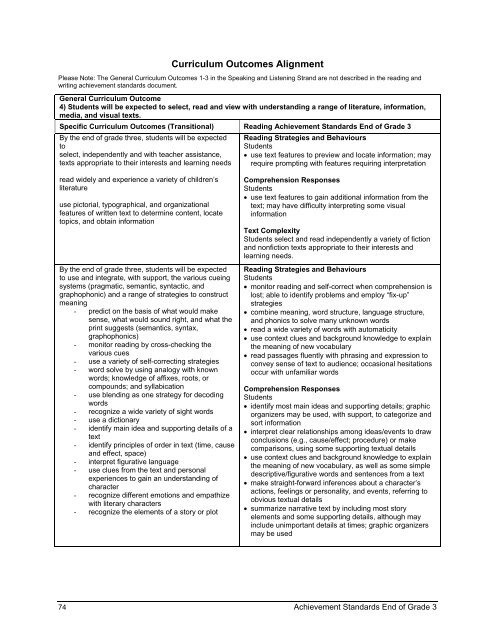Reading and Writing Achievement Standards Curriculum
Reading and Writing Achievement Standards Curriculum
Reading and Writing Achievement Standards Curriculum
Create successful ePaper yourself
Turn your PDF publications into a flip-book with our unique Google optimized e-Paper software.
<strong>Curriculum</strong> Outcomes Alignment<br />
Please Note: The General <strong>Curriculum</strong> Outcomes 1-3 in the Speaking <strong>and</strong> Listening Str<strong>and</strong> are not described in the reading <strong>and</strong><br />
writing achievement st<strong>and</strong>ards document.<br />
General <strong>Curriculum</strong> Outcome<br />
4) Students will be expected to select, read <strong>and</strong> view with underst<strong>and</strong>ing a range of literature, information,<br />
media, <strong>and</strong> visual texts.<br />
Specific <strong>Curriculum</strong> Outcomes (Transitional) <strong>Reading</strong> <strong>Achievement</strong> St<strong>and</strong>ards End of Grade 3<br />
By the end of grade three, students will be expected<br />
to<br />
select, independently <strong>and</strong> with teacher assistance,<br />
texts appropriate to their interests <strong>and</strong> learning needs<br />
<strong>Reading</strong> Strategies <strong>and</strong> Behaviours<br />
Students<br />
• use text features to preview <strong>and</strong> locate information; may<br />
require prompting with features requiring interpretation<br />
read widely <strong>and</strong> experience a variety of children’s<br />
literature<br />
use pictorial, typographical, <strong>and</strong> organizational<br />
features of written text to determine content, locate<br />
topics, <strong>and</strong> obtain information<br />
By the end of grade three, students will be expected<br />
to use <strong>and</strong> integrate, with support, the various cueing<br />
systems (pragmatic, semantic, syntactic, <strong>and</strong><br />
graphophonic) <strong>and</strong> a range of strategies to construct<br />
meaning<br />
- predict on the basis of what would make<br />
sense, what would sound right, <strong>and</strong> what the<br />
print suggests (semantics, syntax,<br />
graphophonics)<br />
- monitor reading by cross-checking the<br />
various cues<br />
- use a variety of self-correcting strategies<br />
- word solve by using analogy with known<br />
words; knowledge of affixes, roots, or<br />
compounds; <strong>and</strong> syllabication<br />
- use blending as one strategy for decoding<br />
words<br />
- recognize a wide variety of sight words<br />
- use a dictionary<br />
- identify main idea <strong>and</strong> supporting details of a<br />
text<br />
- identify principles of order in text (time, cause<br />
<strong>and</strong> effect, space)<br />
- interpret figurative language<br />
- use clues from the text <strong>and</strong> personal<br />
experiences to gain an underst<strong>and</strong>ing of<br />
character<br />
- recognize different emotions <strong>and</strong> empathize<br />
with literary characters<br />
- recognize the elements of a story or plot<br />
Comprehension Responses<br />
Students<br />
• use text features to gain additional information from the<br />
text; may have difficulty interpreting some visual<br />
information<br />
Text Complexity<br />
Students select <strong>and</strong> read independently a variety of fiction<br />
<strong>and</strong> nonfiction texts appropriate to their interests <strong>and</strong><br />
learning needs.<br />
<strong>Reading</strong> Strategies <strong>and</strong> Behaviours<br />
Students<br />
• monitor reading <strong>and</strong> self-correct when comprehension is<br />
lost; able to identify problems <strong>and</strong> employ “fix-up”<br />
strategies<br />
• combine meaning, word structure, language structure,<br />
<strong>and</strong> phonics to solve many unknown words<br />
• read a wide variety of words with automaticity<br />
• use context clues <strong>and</strong> background knowledge to explain<br />
the meaning of new vocabulary<br />
• read passages fluently with phrasing <strong>and</strong> expression to<br />
convey sense of text to audience; occasional hesitations<br />
occur with unfamiliar words<br />
Comprehension Responses<br />
Students<br />
• identify most main ideas <strong>and</strong> supporting details; graphic<br />
organizers may be used, with support, to categorize <strong>and</strong><br />
sort information<br />
• interpret clear relationships among ideas/events to draw<br />
conclusions (e.g., cause/effect; procedure) or make<br />
comparisons, using some supporting textual details<br />
• use context clues <strong>and</strong> background knowledge to explain<br />
the meaning of new vocabulary, as well as some simple<br />
descriptive/figurative words <strong>and</strong> sentences from a text<br />
• make straight-forward inferences about a character’s<br />
actions, feelings or personality, <strong>and</strong> events, referring to<br />
obvious textual details<br />
• summarize narrative text by including most story<br />
elements <strong>and</strong> some supporting details, although may<br />
include unimportant details at times; graphic organizers<br />
may be used<br />
74 <strong>Achievement</strong> St<strong>and</strong>ards End of Grade 3
















